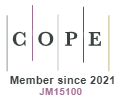Instrukcja redakcyjna
Artykuł powinien być zredagowany w edytorze Word zgodnie z następującymi zasadami:
- imię i nazwisko autora (autorów) – w lewym górnym rogu pogrubioną czcionką 12 pkt; afiliacja autora (autorów), nr ORCID, adres e-mail – do lewej, czcionka 12 pkt;
- tytuł: wyśrodkowany, pogrubioną czcionką 12 pkt;
- streszczenie po polsku – 10 pkt (poprzedzone pogrubionym słowem Streszczenie);
- słowa kluczowe w kolejności alfabetycznej – 10 pkt;
- tytuł po angielsku – wyśrodkowany, pogrubioną czcionką 10 pkt;
- streszczenie po angielsku – 10 pkt (poprzedzone pogrubionym słowem Summary);
- słowa kluczowe po angielsku w kolejności polskich odpowiedników – 10 pkt;
- marginesy: 2,5 cm;
- wcięcie akapitowe w tekście: 1,25 cm;
- tekst artykułu oraz przypisy wyjustowane, bez dzielenia wyrazów;
- czcionka:
- tekst główny – 12 pkt Times New Roman, interlinia – 1,5 pkt,
- przypisy – 10 pkt Times New Roman, interlinia – 1 pkt;
- każdy element graficzny (tabela, wykres, fotografia itp.) w tekście powinien być opatrzony tytułem (wyśrodkowany, umieszczony nad elementem graficznym) oraz informacją o źródle (wyśrodkowana, umieszczona pod elementem graficznym);
- prosimy o dołączanie do wszystkich ilustracji w czasopismach opisów alternatywnych: jak powinien wyglądać tekst alternatywny?;
- cytaty:
- włączone w tekst (do 4 wersów) w cudzysłowie;
- dłuższe cytaty (ponadczterowersowe) – czcionka 10 pkt, wcięcie z lewej 0,5, interlinia – 1 pkt;
- zwroty obcojęzyczne wplecione w tekst polski – kursywą;
- analizowane wyrażenia – kursywą;
- znaczenia omawianych wyrazów w tzw. łapkach ‘ ’;
- wyróżnienia – pogrubione;
- śródtytuły – czcionka 12 pkt pogrubiona;
- uwagi odautorskie (w tym opuszczenia w cytatach): w nawiasach kwadratowych;
- w tekście artykułu posługujemy się skrótami (jak: r., w., m.in., 1. os. lm.);
- przywołując autora pierwszy raz, podajemy imię i nazwisko; drugie i kolejne przywołanie: inicjał + nazwisko.
Informacje bibliograficzne:
- w tekście głównym, w nawiasie okrągłym wg wzoru: nazwisko autora, rok wydania, po dwukropku numer strony, np. (Wierzbicka 1999: 13);
- pod tekstem pełne adresy bibliograficzne:
- nagłówek: Literatura (12 pkt, pogrubione);
- tytuły książek, rozdziałów, artykułów – kursywą;
- tytuły czasopism – w cudzysłowie.
Wzory opisu bibliograficznego:
- Wierzbicka A., 1999, Język – umysł – kultura, Warszawa: Wydawnictwo Naukowe PWN.
- Bajerowa I., 1977, Aktualne problemy polityki językowej, „Socjolingwistyka”, t. 1, s. 4–18.
Jeśli publikacji nadano identyfikator DOI, prosimy o zamieszczenie go w formie linku (http://dx.doi.org/…) na końcu opisu bibliograficznego, np. Stachowski M., 2018, Problemy metodologiczne z badaniem orientalizmów w języku polskim, „Studia Językoznawcze”, t. 17, s. 303–314. https://doi.org/10.18276/sj.2018.17-19
- Gajda S. (red.), 2008, Tożsamość a język w perspektywie slawistycznej, Opole: Uniwersytet Opolski. Instytut Filologii Polskiej.
- Walczak B., 2008, Tradycja i nowoczesność – względność antynomii, w: E. Woźniak (red.), Tradycja a nowoczesność, Łódź: Archidiecezjalne Wydawnictwo Łódzkie, s. 39–47.
- Bauer Z., 2009, „Twój głos w Twoim domu”: cztery typy tabloidyzacji, http://www.slideshare.net/52zbigi/tabloidyzacja (dostęp: 12.04.2016).
- Wierzbicka A., b.r., „Miód tajony” w utworze T. Lenartowicza, http://poradnia-jezykowa.uni.lodz.pl/odpowiedzi/ (dostęp: 12.04.2016).
- NKJP: Narodowy Korpus Języka Polskiego, http://nkjp.pl (dostęp: 23.04.2013).
- http://filolog.uni.lodz.pl/ (dostęp: 12.04.2016).
Stosowane skróty:
- pod tekstem, przed literaturą;
- nagłówek: Wykaz skrótów (12 pkt, pogrubione).
Ze względu na stosowaną procedurę double-blind review prosimy o przesłanie dwu wersji tekstu: pełnej i zanonimizowanej.
Wersja pełna – zgodna z powyższymi wytycznymi.
Wersja zanonimizowana:
- pomijamy nagłówek, tj. imię i nazwisko autora, afiliację, numer ORCID;
- w przypisach i bibliografii – zamiast nazwiska autora i tytułu dzieła posługujemy się formami Nomen Auctoris i Opus;
- nazwa pliku nie może zawierać nazwiska autora; z właściwości pliku należy usunąć imię i nazwisko autora i wszystkie dane umożliwiające jego identyfikację.





